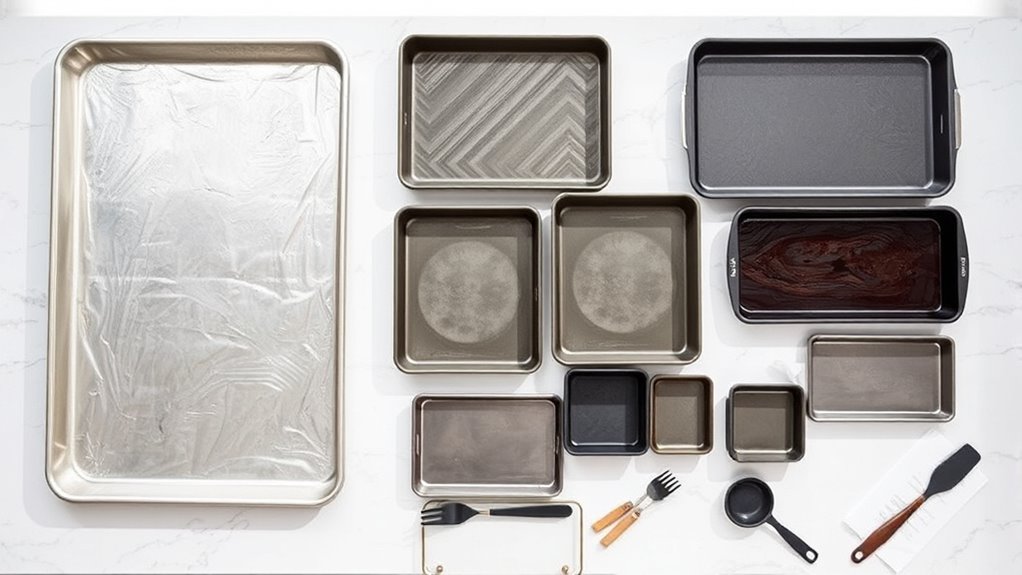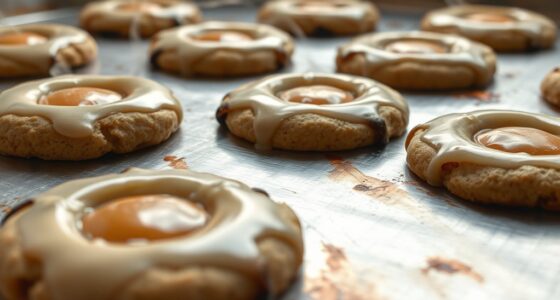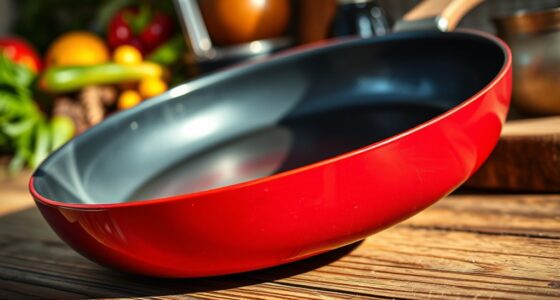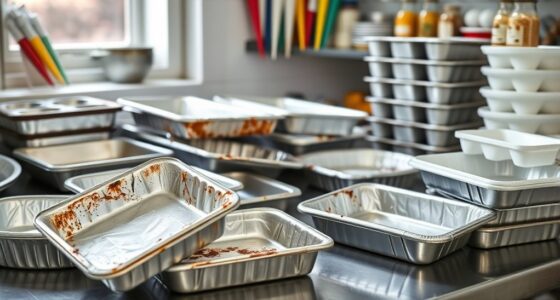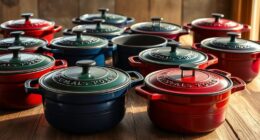Choosing the right sheet pan size and material can improve your cooking results and save space. The most common size is the half-sheet (about 18×13 inches), perfect for most baking needs, while quarter-sheets (around 13×9 inches) work well for smaller tasks. Aluminum pans heat evenly and are great for cookies, while steel pans offer durability. Proper selection guarantees even cooking and efficient use of your oven. Keep exploring to discover tips tailored to your kitchen setup.
Key Takeaways
- Standard sheet pans include half-sheet (18×13 inches) and quarter-sheet (13×9 inches), suitable for different batch sizes and tasks.
- Larger pans facilitate roasting multiple ingredients simultaneously but require more ingredients and longer cooking times.
- Smaller pans are ideal for quick baking, small batches, or limited oven space, offering convenience and efficiency.
- Material choices like aluminum for even heat or steel for durability influence baking outcomes and cleaning ease.
- Proper storage options, such as stacking or vertical racks, help optimize space and prolong the lifespan of sheet pans.

Choosing the right sheet pan size can make a big difference in your cooking and baking results. Whether you’re roasting vegetables, baking cookies, or preparing a sheet pan dinner, selecting the appropriate size ensures even cooking and efficient use of your oven space. The first thing to regard is the baking sheet materials, as they influence heat conduction, durability, and ease of cleaning. Common materials include aluminum, which heats quickly and evenly, making it ideal for baking cookies and pastries. Steel pans are sturdy and often come with non-stick coatings, but they can sometimes conduct heat unevenly if not well-made. Non-stick coatings are convenient for easy cleanup and for baking delicate items, but they may wear out over time. Some bakers also prefer silicone-coated pans, which combine the benefits of non-stick surfaces with flexibility, though they may not be suitable for all oven types. When choosing a sheet pan, think about your typical baking needs and the material that best complements your cooking style.
Beyond selecting the right material, you should also ponder sheet pan storage options. Because sheet pans are often large and flat, they can take up a lot of space in your kitchen cabinets or drawers. To maximize storage, consider stackable pans or pans with rims that allow for nesting without scratching the surface. Some people opt for vertical racks designed specifically for sheet pans, which keep them organized and easily accessible. If storage space is limited, stackable or sliding drawer options can help you keep your pans neatly tucked away while still being quick to grab when needed. Proper storage not only extends the lifespan of your sheet pans but also keeps your kitchen organized and clutter-free.
In terms of size, sheet pans generally come in standard dimensions like half-sheet (roughly 18 x 13 inches) and quarter-sheet (around 13 x 9 inches). The half-sheet size is most versatile, suitable for larger baking batches and roasting larger vegetables or meats. Quarter-sheet pans are perfect for smaller tasks, like roasting a handful of vegetables or baking small cookies. When choosing a size, think about the capacity you need and the space available in your oven. Remember, a larger sheet pan may require more ingredients and longer cooking times, but it also allows you to prepare bigger batches at once. Meanwhile, a smaller pan is more convenient for quick tasks and limited oven space.
Frequently Asked Questions
What Materials Are Best for Non-Stick Sheet Pans?
For the best non-stick sheet pans, look for those with high-quality non-stick coatings like ceramic or PTFE. These coatings guarantee easy food release and simplify cleaning. Aluminum pans with non-stick coatings are popular due to their excellent bakeware durability and even heat distribution. Avoid pans with cheap coatings that chip or wear quickly, as durable materials make your baking experience more reliable and long-lasting.
How Do I Clean and Maintain Different Sheet Pan Types?
Imagine your sheet pan’s screaming, “Help, I’m filthy!” after a messy roast. You should clean it with gentle scrubbing using warm soapy water or baking soda paste for stubborn stains. For storage, stack pans carefully or hang them to avoid scratches. Regular cleaning techniques keep your pans in top shape, preventing rust and sticking. Treat them well, and they’ll keep serving you delicious meals without the drama.
Can Sheet Pans Be Used in Convection Ovens?
Yes, you can use sheet pans in convection ovens, but you should consider oven safety and pan insulation. Make certain your sheet pan is oven-safe and heat-resistant, as convection ovens circulate hot air efficiently. Proper pan insulation helps prevent warping or damage. Always check the manufacturer’s guidelines for your specific pan, and avoid overcrowding, so heat circulates evenly, ensuring safe and effective baking or roasting.
Are There Eco-Friendly Options for Sheet Pans?
Yes, you can find eco-friendly sheet pans made from recyclable materials like aluminum or stainless steel, which reduce environmental impact. Look for options with eco-friendly coatings that are non-toxic and safe for the environment. These pans are durable, reusable, and help you cook sustainably. Choosing such options supports eco-conscious practices and minimizes waste, making them a smart choice for environmentally aware kitchens.
How Do Sheet Pan Sizes Differ Internationally?
International sizing standards vary, so you’ll notice regional pan dimensions differ across countries. In the US, sheet pans are typically measured in inches, with common sizes like 18×13 inches. Europe and Asia often use metric measurements, such as 600x400mm. These differences mean you should check regional specifications before purchasing or using a sheet pan, ensuring it fits your oven and meets your cooking needs seamlessly.
Conclusion
Now that you know the different sheet pan sizes and their uses, you might wonder if bigger is always better. While larger pans are great for roasting veggies or baking multiple cookies, smaller ones offer more control and even cooking for delicate tasks. It’s a common myth that bigger pans are universally superior, but choosing the right size depends on your needs. Experiment with various sizes—you might find the perfect fit for your kitchen adventures!
